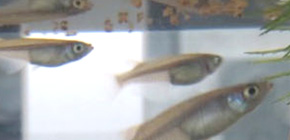
Structural changes in taste receptors in the first stage of taste perception discovered
A group of researchers led by Professor YAMASHITA Atsuko (Graduate School of Medicine, Dentistry and Pharmaceutical Sciences), Researchers NANGO Eriko , ASHIKAWA Yuji , and Maki-Yonekura Saori (RIKEN Spring-8 Center), Unit Head KUSAKABE Yuko (National Food Research Institute, National Agriculture and Food Research Organization), and Associate Professor UCHIYAMA Susumu (Graduate School of Engineering, Osaka University) clarified that extracellular regions of taste receptor proteins, which serve as a sensor of taste substances in the mouth, structurally changed by binding taste substances.
Of the taste receptors, receptors perceiving sweetness and umami are on the membranes of taste cells that perceive taste substances, and protrude two-thirds of the way through the cell. This group clarified that a change from a widely-spread to a compactly-organized state was made once taste substances bound to these extracellular regions. This structural change is thought to trigger the transmission of taste substance binding, which occurred extracellularly, to within a taste cell.
This group screened a variety of taste receptors. Most taste receptors, including humans’, cannot be properly produced in laboratories; of the samples they examined, only extracellular domains of taste receptor T1r2/T1r3 heterodimer of medaka fish were properly produced by using insect cells. As a result of analysis using these purified proteins, it was found that extracellular domains of taste receptor T1r2/T1r3 heterodimer bound amino acids - medaka fish reportedly showed preferences to the foods containing amino acids - in the concentration range of a few μM to a few hundred μM, and that along with these bindings, the structural change from a widely-spread to compactly-organized state took place.
In similar receptors, two patterns of structural change had been reported: A. Protein molecules consisting of a dimer made structural changes independently and B. Mutual interaction of dimers made changes. It was found that extracellular structural change of taste receptors observed by this group fell under pattern B.
It is thought that through the extracellular structural change of taste receptors, the structural change was transmitted to the transmembrane and intracellular domains, which occupy the remaining one third of the receptor, and information about extracellular binding of taste substances is transmitted to the inside of cells.
This group’s research results will become basic information necessary for understanding the mechanism behind taste perception and will lead to the development of new taste substance evaluation systems using the detection of structural changes in taste receptors.
Abstract
Sweet and umami tastes are perceived by T1r taste receptors in oral cavity. T1rs are class C G-protein coupled receptors (GPCRs), and the extracellular ligand binding domains (LBDs) of T1r1/T1r3 and T1r2/T1r3 heterodimers are responsible for binding of chemical substances eliciting umami or sweet taste. However, molecular analyses of T1r have been hampered due to the difficulties in recombinant expression and protein purification, and thus little is known about mechanisms for taste perception. Here we show the first molecular view of reception of a taste substance by a taste receptor, where the binding of the taste substance elicits a different conformational state of T1r2/T1r3 LBD heterodimer. Electron microscopy has showed a characteristic dimeric structure. F?rster resonance energy transfer and X-ray solution scattering have revealed the transition of the dimerization manner of the ligand binding domains, from a widely spread to compactly organized state upon taste substance binding, which may correspond to distinct receptor functional states.

Conformational change of T1r taste receptor is induced by the binding to sweet or umami taste.
Present biophysical experiments using the taste receptor from medaka fish showed the dimer of the receptor takes compact formation upon the binding to sweet or umami taste.
To learn more about this research, please view the full research report entitled " Taste substance binding elicits conformational change of taste receptor T1r heterodimer extracellular domains " at this page of the Scientific Reports website.
Related links
